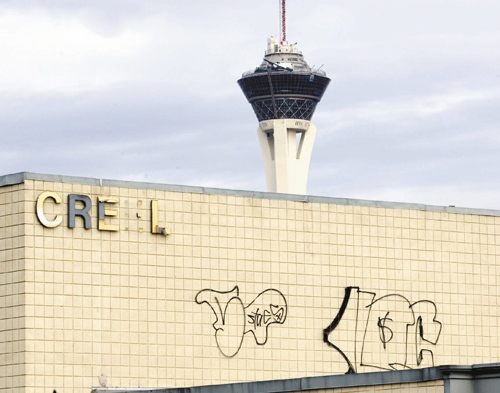Graffiti draws attention
As she guides her pickup through her neighborhood, Carri easily picks out the sloppy scrawls and letters marring a wall here, a fence there.
More taggers have been through.
RMCK is at it again. So is HBK and a host of other vandals looking to leave their marks.
Carri, who didn't want her last name used for fear of retribution, notes the locations. As president of the Northeast Pride Committee, she will need to coordinate with other volunteers and give them the right color of paint to cover the fresh graffiti.
That's what she has done for six years in her neighborhood near Pecos and Alexander roads.
"When it goes up, we remove it," she said. "The quicker you take the graffiti away the better."
The battle against graffiti goes on every day across Southern Nevada. From the streets of northeast Las Vegas to the ancient artwork at Red Rock Canyon, police, governments and residents spend countless hours and millions of dollars each year in the fight against graffiti vandals who can't wait to throw their tags on walls, freeway signs, houses, bathroom stalls and just about anywhere else they can.
Las Vegas spends $1.5 million a year on graffiti cleanup. Clark County's code enforcement spends $2.5 million. And the county recently estimated the annual public and private cost of graffiti valleywide at $30 million.
Cleaning and restoring 1,000-year-old artwork defaced by a tagger at Red Rock Canyon will cost an estimated $10,000.
Las Vegas police arrested a 17-year-old nicknamed Pee Wee. He is charged as a juvenile under the state's anti-graffiti law, though he could be charged under the federal Archaeological Resources Protection Act. That felony carries a fine of up to $100,000 and five years in prison.
Las Vegas Mayor Oscar Goodman, who once recommended cutting off the thumbs of graffiti vandals, said he was heartsick after learning of the damage at Red Rock Canyon.
"We have to set an example," the mayor said of Pee Wee. The teen should be locked in a cage where people can throw permanent paint on him, he said.
"Even my punishment might be too good for him," Goodman said.
Pee Wee was a member of a tagging crew, a gang intent on spreading graffiti.
Tagging crews account for more than 90 percent of the graffiti in Southern Nevada, said Detective Scott Black of the Metropolitan Police Department Graffiti Investigations Detail.
Tagging crews put their marks anywhere and everywhere, especially in highly visible places, to boost their fame, said Black, who has identified more than 500 tagging crews in his decade investigating graffiti.
Riskier locations, such as road signs high above freeways or a local landmark, gain the tagger more street cred and respect from peers. Taggers scale walls, shimmy up light poles and dangle upside down from freeway overpasses, all in the name of fame.
"They love the fame they get," Black said. "They love the rush they get."
Tagging on or near an iconic landmark adds another dimension to a tagger's notoriety, which is why Las Vegas has attracted taggers from around the world, he said.
Sometimes taggers go for quantity over quality. Black recalled a tagger who put his mark on any stop sign he could find. The reason: It was impossible to ignore for passing motorists.
"He got a rush out of that. He wanted as many people to see his tag as possible," Black said.
The rise of online social media websites has helped taggers get more famous. They can post their latest work and videos on websites and easily spread their names and works nationwide.
The Las Vegas police graffiti unit makes about 300 arrests a year. The detectives use their expertise to build cases against taggers, often connecting them to dozens of locations.
But few taggers fear arrest, Black said. If convicted they might lose their driver's license, have to pay restitution and be sentenced to spending their weekends painting over graffiti, but the boost to their profile makes it worthwhile.
Most taggers start young -- Black has arrested an 8-year-old -- and give it up when they hit their mid-20s and mature. But for some taggers, the addictive thrill of putting up graffiti is like a drug habit that they can't kick, Black said.
It's not uncommon for police to arrest prolific taggers 20 times or more and to find taggers in their 30s, he said. He has arrested more than one tagger in his early 40s. And they come from all backgrounds, such as the married father of three who held a hotel management position on the Strip.
While some defenders of graffiti categorize it as an art form, Black said it's nothing of the sort.
"This has nothing to do with art. If it's not against the law, they won't do it."
If a tagger gets permission to paint a wall or fence, it's not a crime. But that rarely happens because breaking the law is part of the thrill, as is achieving maximum shock value, he said.
To help prevent graffiti vandalism, local governments have created ordinances making it harder for taggers to find the tools of their trade. For example, hardware stores must lock up spray paint, limiting access to employees.
Las Vegas and Clark County recently changed their ordinances that make it a misdemeanor for anyone to carry graffiti implements, such as large markers and spray cans, without a valid reason. The law used to apply only to juveniles.
Nevada lawmakers also have toughened the state's anti-graffiti law. In 2007, they created a graffiti-specific law, removing it from the catch-all vandalism statute.
The law makes all graffiti a crime, whether it's 30-foot spray-painted letters on a warehouse or a sticker on a courthouse bathroom wall. The amount of damage determines whether it's a misdemeanor or a felony.
Beyond any jail time or monetary penalties, taggers will be sentenced to community service, painting over graffiti.
Painting over the vandalism plays a large part in controlling it, which is why local governments spend so much in paint and manpower each year.
Thank the Broken Window Theory, said Joe Boteilho, the county's code enforcement chief.
The idea, which helped reverse the decline of New York City in the 1990s, focuses on smaller problems, such as graffiti and broken windows, to prevent them from mushrooming into bigger problems and more serious crimes.
For example, leaving graffiti on a wall invites other taggers to add their marks, soon covering the entire wall. So local graffiti abatement crews work almost every day. Volunteer groups help, as do Clark County Detention Center inmates and taggers serving community service.
In some neighborhoods, like Carri's, the residents have taken it upon themselves to keep graffiti in check.
Almost daily, someone from their volunteer group of about a dozen residents takes a 5-gallon bucket of paint provided by the county and covers up fresh graffiti. Signs of their work can be seen up and down the neighborhood's concrete block walls and vinyl fences.
In many places all that is visible are squares of dried paint where graffiti once showed. In others, the dark lines of the graffiti show through the coat of light-colored paint, waiting for a second coat.
Staying on top of the tagging can be a lot of work, but the alternative for Carri and the others is letting the criminals claim victory.
"We don't want to give up, because if we give up, they've won," she said.
Contact reporter Brian Haynes at
bhaynes@reviewjournal.com or 702-383-0281.
TO REPORT GRAFFITI:
Clark County graffiti hotline, 455-4509.
Graffiti inside incorporated areas will be forwarded to the appropriate city.




























